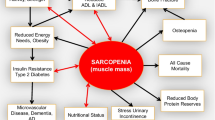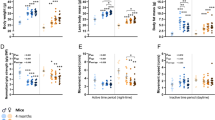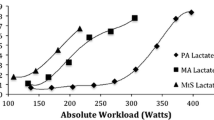Abstract
Purpose
The aim of this study was to determine if the expression of the mitochondrial biogenesis-regulating proteins SIRT1, SIRT3 and PGC-1alpha in human skeletal muscle is influenced by adiposity.
Method
Twenty-nine male subjects were recruited into three groups: control (n = 10), obese (n = 10) and post-obese (n = 9). Intentionally, groups were matched by age, aerobic capacity and in addition the control and post-obese groups also by BMI. Muscle biopsies were obtained from the m. deltoid and vastus lateralis. PGC-1alpha, SIRT1 and SIRT3 protein expression was analyzed by Western blot.
Result
PGC-1alpha, SIRT1 and SIRT3 protein expression was similar regardless of the level of adiposity. Only a main effect of group on SIRT1 protein showed a trend toward higher expression in post-obese than control and obese (P = 0.09). Despite similar muscle fiber-type composition (previously reported), PGC-1alpha, SIRT1 and SIRT3 protein expression was higher in leg compared to arm muscle in all groups (P < 0.05).
Conclusion
This study shows that PGC-1alpha, SIRT1 and SIRT3 protein expression in basal conditions was not altered in humans with different levels of adiposity but similar aerobic capacity. The expression of PGC-1alpha, SIRT1 and SIRT3 was higher in vastus lateralis than in deltoid muscle, indicating that local rather than systemic factors prevail in regulating the level of expression of these proteins.

Similar content being viewed by others
Abbreviations
- ACC:
-
Acetyl-coenzyme A carboxylase
- AMPK:
-
5′ AMP-activated protein kinase
- ANOVA:
-
One-way analyses of variance
- BMI:
-
Body mass index
- C:
-
Control
- CS:
-
Citrate synthase
- DXA:
-
Dual-energy X-ray absorptiometry
- HAD:
-
β-Hydroxy-acyl-CoA-dehydrogenase
- HSL:
-
Hormone-sensitive lipase
- IPAQ:
-
International Physical Activity Questionnaire
- LB:
-
Lower body
- MFO:
-
Maximal fat oxidation
- O:
-
Obese
- OGTT:
-
Oral glucose tolerance test
- PDH:
-
Pyruvate dehydrogenase
- PDK4:
-
Pyruvate dehydrogenase kinase-4
- PGC-1alpha:
-
Peroxisome proliferator-activated receptor-γ coactivator-1α
- PO:
-
Postobese
- Ser:
-
Serine
- Sir2:
-
Silent information regulator 2
- SIRT1:
-
Sirtuin 1
- SIRT3:
-
Sirtuin 3
- TCA:
-
Tricarboxylic acid cycle or the Krebs cycle
- Thr:
-
Threonine
- UB:
-
Upper body
References
Achten J, Gleeson M, Jeukendrup AE (2002) Determination of the exercise intensity that elicits maximal fat oxidation. Med Sci Sports Exerc 34(1):92–97
Ahlborg G, Jensen-Urstad M (1991) Metabolism in exercising arm vs. leg muscle. Clin Physiol 11(5):459–468
Ahn BH, Kim HS, Song S, Lee IH, Liu J, Vassilopoulos A, Deng CX, Finkel T (2008) A role for the mitochondrial deacetylase Sirt3 in regulating energy homeostasis. Proc Natl Acad Sci USA 105(38):14447–14452. doi:10.1073/pnas.0803790105
Amat R, Solanes G, Giralt M, Villarroya F (2007) SIRT1 is involved in glucocorticoid-mediated control of uncoupling protein-3 gene transcription. J Biol Chem 282(47):34066–34076. doi:10.1074/jbc.M707114200
Amat R, Planavila A, Chen SL, Iglesias R, Giralt M, Villarroya F (2009) SIRT1 controls the transcription of the peroxisome proliferator-activated receptor-gamma Co-activator-1alpha (PGC-1alpha) gene in skeletal muscle through the PGC-1alpha autoregulatory loop and interaction with MyoD. J Biol Chem 284(33):21872–21880. doi:10.1074/jbc.M109.022749
Ara I, Larsen S, Stallknecht B, Guerra B, Morales-Alamo D, Andersen JL, Ponce-Gonzalez JG, Guadalupe-Grau A, Galbo H, Calbet JA, Helge JW (2011) Normal mitochondrial function and increased fat oxidation capacity in leg and arm muscles in obese humans. Int J Obes (Lond) 35(1):99–108. doi:10.1038/ijo.2010.123
Boushel R, Ara I, Gnaiger E, Helge JW, Gonzalez-Alonso J, Munck-Andersen T, Sondergaard H, Damsgaard R, van Hall G, Saltin B, Calbet JA (2014) Low-intensity training increases peak arm VO2 by enhancing both convective and diffusive O2 delivery. Acta Physiol (Oxf) 211(1):122–134. doi:10.1111/apha.12258
Calbet JA, Holmberg HC, Rosdahl H, van Hall G, Jensen-Urstad M, Saltin B (2005) Why do arms extract less oxygen than legs during exercise? Am J Physiol Regul Integr Comp Physiol 289(5):R1448–R1458. doi:10.1152/ajpregu.00824.2004
Canto C, Jiang LQ, Deshmukh AS, Mataki C, Coste A, Lagouge M, Zierath JR, Auwerx J (2010) Interdependence of AMPK and SIRT1 for metabolic adaptation to fasting and exercise in skeletal muscle. Cell Metab 11(3):213–219. doi:10.1016/j.cmet.2010.02.006
Chalkiadaki A, Igarashi M, Nasamu AS, Knezevic J, Guarente L (2014) Muscle-specific SIRT1 gain-of-function increases slow-twitch fibers and ameliorates pathophysiology in a mouse model of duchenne muscular dystrophy. PLoS Genet 10(7):e1004490. doi:10.1371/journal.pgen.1004490
Chanseaume E, Barquissau V, Salles J, Aucouturier J, Patrac V, Giraudet C, Gryson C, Duche P, Boirie Y, Chardigny JM, Morio B (2010) Muscle mitochondrial oxidative phosphorylation activity, but not content, is altered with abdominal obesity in sedentary men: synergism with changes in insulin sensitivity. J Clin Endocrinol Metab 95(6):2948–2956. doi:10.1210/jc.2009-1938
Chinsomboon J, Ruas J, Gupta RK, Thom R, Shoag J, Rowe GC, Sawada N, Raghuram S, Arany Z (2009) The transcriptional coactivator PGC-1alpha mediates exercise-induced angiogenesis in skeletal muscle. Proc Natl Acad Sci USA 106(50):21401–21406. doi:10.1073/pnas.0909131106
Chomentowski P, Dube JJ, Amati F, Stefanovic-Racic M, Zhu S, Toledo FG, Goodpaster BH (2009) Moderate exercise attenuates the loss of skeletal muscle mass that occurs with intentional caloric restriction-induced weight loss in older, overweight to obese adults. J Gerontol A Biol Sci Med Sci 64(5):575–580. doi:10.1093/gerona/glp007
Cimen H, Han MJ, Yang Y, Tong Q, Koc H, Koc EC (2010) Regulation of succinate dehydrogenase activity by SIRT3 in mammalian mitochondria. Biochemistry 49(2):304–311. doi:10.1021/bi901627u
Civitarese AE, Carling S, Heilbronn LK, Hulver MH, Ukropcova B, Deutsch WA, Smith SR, Ravussin E (2007) Calorie restriction increases muscle mitochondrial biogenesis in healthy humans. PLoS Med 4(3):e76. doi:10.1371/journal.pmed.0040076
Craig CL, Marshall AL, Sjostrom M, Bauman AE, Booth ML, Ainsworth BE, Pratt M, Ekelund U, Yngve A, Sallis JF, Oja P (2003) International physical activity questionnaire: 12-country reliability and validity. Med Sci Sports Exerc 35(8):1381–1395. doi:10.1249/01.MSS.0000078924.61453.FB
De Filippis E, Alvarez G, Berria R, Cusi K, Everman S, Meyer C, Mandarino LJ (2008) Insulin-resistant muscle is exercise resistant: evidence for reduced response of nuclear-encoded mitochondrial genes to exercise. Am J Physiol Endocrinol Metab 294(3):E607–E614. doi:10.1152/ajpendo.00729.2007
Fuentes T, Ara I, Guadalupe-Grau A, Larsen S, Stallknecht B, Olmedillas H, Santana A, Helge JW, Calbet JA, Guerra B (2010) Leptin receptor 170 kDa (OB-R170) protein expression is reduced in obese human skeletal muscle: a potential mechanism of leptin resistance. Exp Physiol 95(1):160–171. doi:10.1113/expphysiol.2009.049270
Garcia-Martinez C, Sibille B, Solanes G, Darimont C, Mace K, Villarroya F, Gomez-Foix AM (2001) Overexpression of UCP3 in cultured human muscle lowers mitochondrial membrane potential, raises ATP/ADP ratio, and favors fatty acid vs. glucose oxidation. FASEB J 15(11):2033–2035. doi:10.1096/fj.00-0828fje
Gerhart-Hines Z, Rodgers JT, Bare O, Lerin C, Kim SH, Mostoslavsky R, Alt FW, Wu Z, Puigserver P (2007) Metabolic control of muscle mitochondrial function and fatty acid oxidation through SIRT1/PGC-1alpha. EMBO J 26(7):1913–1923
Gong DW, Monemdjou S, Gavrilova O, Leon LR, Marcus-Samuels B, Chou CJ, Everett C, Kozak LP, Li C, Deng C, Harper ME, Reitman ML (2000) Lack of obesity and normal response to fasting and thyroid hormone in mice lacking uncoupling protein-3. J Biol Chem 275(21):16251–16257. doi:10.1074/jbc.M910177199
Goodpaster BH, Wolfe RR, Kelley DE (2002) Effects of obesity on substrate utilization during exercise. Obes Res 10(7):575–584. doi:10.1038/oby.2002.78
Guadalupe-Grau A, Rodríguez-García L, Torres-Peralta R, Morales-Álamo D, Ponce-Gonzalez JG, Suarez-Pérez I, Santana A, Calbet JAL (2015) Greater basal skeletal muscle AMPKα phosphorylation in men than in women: Associations with anaerobic performance. Eur J Sport Sci. doi:10.1080/17461391.2015.1063701
Guerra B, Guadalupe-Grau A, Fuentes T, Ponce-Gonzalez JG, Morales-Alamo D, Olmedillas H, Guillen-Salgado J, Santana A, Calbet JA (2010) SIRT1, AMP-activated protein kinase phosphorylation and downstream kinases in response to a single bout of sprint exercise: influence of glucose ingestion. Eur J Appl Physiol 109(4):731–743. doi:10.1007/s00421-010-1413-y
Gurd BJ (2011) Deacetylation of PGC-1alpha by SIRT1: importance for skeletal muscle function and exercise-induced mitochondrial biogenesis. Appl Physiol Nutr Metab 36(5):589–597. doi:10.1139/h11-070
Gurd BJ, Holloway GP, Yoshida Y, Bonen A (2011) In mammalian muscle, SIRT3 is present in mitochondria and not in the nucleus; and SIRT3 is upregulated by chronic muscle contraction in an adenosine monophosphate-activated protein kinase-independent manner. Metabolism. doi:10.1016/j.metabol.2011.09.016
Hallows WC, Lee S, Denu JM (2006) Sirtuins deacetylate and activate mammalian acetyl-CoA synthetases. Proc Natl Acad Sci USA 103(27):10230–10235. doi:10.1073/pnas.0604392103
Hirschey MD, Shimazu T, Goetzman E, Jing E, Schwer B, Lombard DB, Grueter CA, Harris C, Biddinger S, Ilkayeva OR, Stevens RD, Li Y, Saha AK, Ruderman NB, Bain JR, Newgard CB, Farese RV Jr, Alt FW, Kahn CR, Verdin E (2010) SIRT3 regulates mitochondrial fatty-acid oxidation by reversible enzyme deacetylation. Nature 464(7285):121–125. doi:10.1038/nature08778
Hirschey MD, Shimazu T, Huang JY, Schwer B, Verdin E (2011) SIRT3 regulates mitochondrial protein acetylation and intermediary metabolism. Cold Spring Harb Symp Quant Biol. doi:10.1101/sqb.2011.76.010850
Hokari F, Kawasaki E, Sakai A, Koshinaka K, Sakuma K, Kawanaka K (2010) Muscle contractile activity regulates Sirt3 protein expression in rat skeletal muscles. J Appl Physiol 109(2):332–340. doi:10.1152/japplphysiol.00335.2009
Holloway GP, Perry CG, Thrush AB, Heigenhauser GJ, Dyck DJ, Bonen A, Spriet LL (2008) PGC-1alpha’s relationship with skeletal muscle palmitate oxidation is not present with obesity despite maintained PGC-1alpha and PGC-1beta protein. Am J Physiol Endocrinol Metab 294(6):E1060–E1069. doi:10.1152/ajpendo.00726.2007
Horowitz JF, Klein S (2000) Oxidation of nonplasma fatty acids during exercise is increased in women with abdominal obesity. J Appl Physiol 89(6):2276–2282
Jing E, Emanuelli B, Hirschey MD, Boucher J, Lee KY, Lombard D, Verdin EM, Kahn CR (2011) Sirtuin-3 (Sirt3) regulates skeletal muscle metabolism and insulin signaling via altered mitochondrial oxidation and reactive oxygen species production. Proc Natl Acad Sci USA 108(35):14608–14613. doi:10.1073/pnas.1111308108
Kern DS, Semmler JG, Enoka RM (2001) Long-term activity in upper- and lower-limb muscles of humans. J Appl Physiol 91(5):2224–2232
Kiilerich K, Birk JB, Damsgaard R, Wojtaszewski JF, Pilegaard H (2008) Regulation of PDH in human arm and leg muscles at rest and during intense exercise. Am J Physiol Endocrinol Metab 294(1):E36–E42. doi:10.1152/ajpendo.00352.2007
Kong X, Wang R, Xue Y, Liu X, Zhang H, Chen Y, Fang F, Chang Y (2010) Sirtuin 3, a new target of PGC-1alpha, plays an important role in the suppression of ROS and mitochondrial biogenesis. PLoS One 5(7):e11707. doi:10.1371/journal.pone.0011707
Lanza IR, Nair KS (2009) Muscle mitochondrial changes with aging and exercise. Am J Clin Nutr 89(1):467S–471S. doi:10.3945/ajcn.2008.26717D
Lanza IR, Short DK, Short KR, Raghavakaimal S, Basu R, Joyner MJ, McConnell JP, Nair KS (2008) Endurance exercise as a countermeasure for aging. Diabetes 57(11):2933–2942. doi:10.2337/db08-0349
Larsen S, Ara I, Rabol R, Andersen JL, Boushel R, Dela F, Helge JW (2009) Are substrate use during exercise and mitochondrial respiratory capacity decreased in arm and leg muscle in type 2 diabetes? Diabetologia 52(7):1400–1408. doi:10.1007/s00125-009-1353-4
Li L, Muhlfeld C, Niemann B, Pan R, Li R, Hilfiker-Kleiner D, Chen Y, Rohrbach S (2011) Mitochondrial biogenesis and PGC-1alpha deacetylation by chronic treadmill exercise: differential response in cardiac and skeletal muscle. Basic Res Cardiol 106(6):1221–1234. doi:10.1007/s00395-011-0213-9
Lima-Silva AE, Bertuzzi RC, Pires FO, Gagliardi JF, Barros RV, Hammond J, Kiss MA (2010) Relationship between training status and maximal fat oxidation rate. J Sports Sci Med 9(1):31–35
Lin J, Wu H, Tarr PT, Zhang CY, Wu Z, Boss O, Michael LF, Puigserver P, Isotani E, Olson EN, Lowell BB, Bassel-Duby R, Spiegelman BM (2002) Transcriptional co-activator PGC-1 alpha drives the formation of slow-twitch muscle fibres. Nature 418(6899):797–801. doi:10.1038/nature00904
McCarthy J, Lochner A, Opie LH, Sack MN, Essop MF (2011) PKCepsilon promotes cardiac mitochondrial and metabolic adaptation to chronic hypobaric hypoxia by GSK3beta inhibition. J Cell Physiol 226(9):2457–2468. doi:10.1002/jcp.22592
Nordby P, Saltin B, Helge JW (2006) Whole-body fat oxidation determined by graded exercise and indirect calorimetry: a role for muscle oxidative capacity? Scand J Med Sci Sports 16(3):209–214. doi:10.1111/j.1600-0838.2005.00480.x
Olsen DB, Sacchetti M, Dela F, Ploug T, Saltin B (2005) Glucose clearance is higher in arm than leg muscle in type 2 diabetes. J Physiol 565(Pt 2):555–562. doi:10.1113/jphysiol.2004.081356
Palacios OM, Carmona JJ, Michan S, Chen KY, Manabe Y, Ward JL 3rd, Goodyear LJ, Tong Q (2009) Diet and exercise signals regulate SIRT3 and activate AMPK and PGC-1alpha in skeletal muscle. Aging (Albany NY) 1(9):771–783
Ringholm S, Bienso RS, Kiilerich K, Guadalupe-Grau A, Aachmann-Andersen NJ, Saltin B, Plomgaard P, Lundby C, Wojtaszewski JF, Calbet JA, Pilegaard H (2011) Bed rest reduces metabolic protein content and abolishes exercise-induced mRNA responses in human skeletal muscle. Am J Physiol Endocrinol Metab 301(4):E649–E658. doi:10.1152/ajpendo.00230.2011
Sandri M, Lin J, Handschin C, Yang W, Arany ZP, Lecker SH, Goldberg AL, Spiegelman BM (2006) PGC-1alpha protects skeletal muscle from atrophy by suppressing FoxO3 action and atrophy-specific gene transcription. Proc Natl Acad Sci USA 103(44):16260–16265. doi:10.1073/pnas.0607795103
Schutz Y, Tremblay A, Weinsier RL, Nelson KM (1992) Role of fat oxidation in the long-term stabilization of body weight in obese women. Am J Clin Nutr 55(3):670–674
Schwer B, Bunkenborg J, Verdin RO, Andersen JS, Verdin E (2006) Reversible lysine acetylation controls the activity of the mitochondrial enzyme acetyl-CoA synthetase 2. Proc Natl Acad Sci USA 103(27):10224–10229. doi:10.1073/pnas.0603968103
Shi T, Wang F, Stieren E, Tong Q (2005) SIRT3, a mitochondrial sirtuin deacetylase, regulates mitochondrial function and thermogenesis in brown adipocytes. J Biol Chem 280(14):13560–13567. doi:10.1074/jbc.M414670200
Vidal-Puig AJ, Grujic D, Zhang CY, Hagen T, Boss O, Ido Y, Szczepanik A, Wade J, Mootha V, Cortright R, Muoio DM, Lowell BB (2000) Energy metabolism in uncoupling protein 3 gene knockout mice. J Biol Chem 275(21):16258–16266. doi:10.1074/jbc.M910179199
Weinheimer EM, Sands LP, Campbell WW (2010) A systematic review of the separate and combined effects of energy restriction and exercise on fat-free mass in middle-aged and older adults: implications for sarcopenic obesity. Nutr Rev 68(7):375–388. doi:10.1111/j.1753-4887.2010.00298.x
Wende AR, Huss JM, Schaeffer PJ, Giguere V, Kelly DP (2005) PGC-1alpha coactivates PDK4 gene expression via the orphan nuclear receptor ERRalpha: a mechanism for transcriptional control of muscle glucose metabolism. Mol Cell Biol 25(24):10684–10694. doi:10.1128/MCB.25.24.10684-10694.2005
Wenz T, Rossi SG, Rotundo RL, Spiegelman BM, Moraes CT (2009) Increased muscle PGC-1alpha expression protects from sarcopenia and metabolic disease during aging. Proc Natl Acad Sci USA 106(48):20405–20410. doi:10.1073/pnas.0911570106
Wu Z, Puigserver P, Andersson U, Zhang C, Adelmant G, Mootha V, Troy A, Cinti S, Lowell B, Scarpulla RC, Spiegelman BM (1999) Mechanisms controlling mitochondrial biogenesis and respiration through the thermogenic coactivator PGC-1. Cell 98(1):115–124. doi:10.1016/S0092-8674(00)80611-X
Zehr EP, Duysens J (2004) Regulation of arm and leg movement during human locomotion. Neuroscientist 10(4):347–361. doi:10.1177/1073858404264680
Acknowledgments
This study was supported by grants from the Ministerio de Educación y Ciencia (DEP2010-21866, and FEDER), FUNCIS (PI/10/07), Programa Innova Canarias 2020 (P.PE03-01-F08), Proyecto Estructurante de la ULPGC: ULPAPD-08/01-4, and Proyecto del Programa Propio de la ULPGC (ULPGC 2009-07), and III Convocatoria de Ayudas a la Investigación Cátedra Real Madrid- UEM (2010/01RM, Universidad Europea de Madrid). Financial support was received from the Novo Nordisk Foundation, The Foundation of 1870 and Christian d. 10 foundation. Furthermore, we thank Jesper Isager Sally, Thomas Beck, Jeppe Bach and Regitze Kraunsøe (all Dept. Biomedical Sciences, University of Copenhagen) for providing excellent technical assistance. In addition, we thank Prof. Bente Stallknecht (Dept. Biomedical Sciences, University of Copenhagen) for performing the biopsies. Special thanks are given to José Navarro de Tuero, and María Carmen García Chicano for their excellent technical assistance.
Author information
Authors and Affiliations
Corresponding author
Ethics declarations
Conflict of interest
The authors declare that they have no conflict of interest.
Additional information
Communicated by Anni Vanhatalo.
Rights and permissions
About this article
Cite this article
Ponce-González, J.G., Ara, I., Larsen, S. et al. Effect of regional muscle location but not adiposity on mitochondrial biogenesis-regulating proteins. Eur J Appl Physiol 116, 11–18 (2016). https://doi.org/10.1007/s00421-015-3232-7
Received:
Accepted:
Published:
Issue Date:
DOI: https://doi.org/10.1007/s00421-015-3232-7




